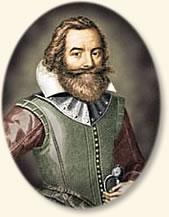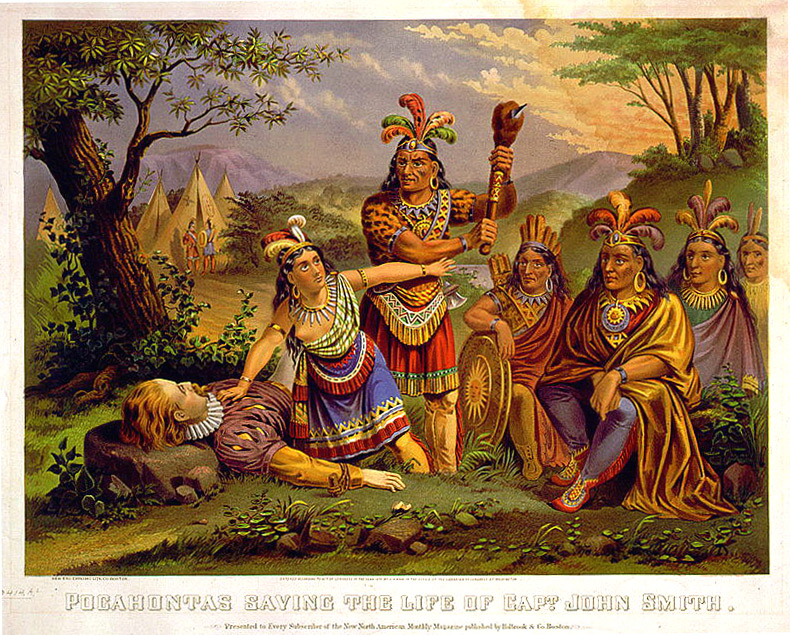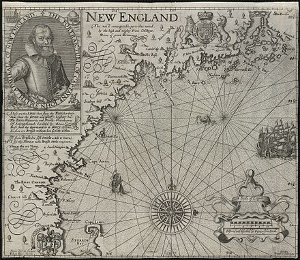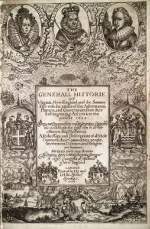John Smith: Stalwart of Colonial Jamestown
John Smith was one of the most influential Englishmen to set foot in early colonial America. He led the Jamestown colony through tough times and produced highly accurate maps of the surrounding regions, including New England. He is also known as an author. 
Smith was born in 1580, in Willoughby, Lincolnshire, England. When he was 16, his father died and he stopped school and, after training as a merchant for a time, left home to pursue a life as a soldier. He fought in France for a time, against Spain, and then went to Hungary 1600 to fight against the Turks. It was during this conflict that he was promoted to the rank of captain. In between fighting in wars, Smith had learned wilderness survival techniques. These would come in handy in his next venture, an expedition with the Virginia Company to establish the Virginia colony in North America. This they did, and they called it Jamestown. Three ships (Discovery, Godspeed, and 
Smith and a few other settlers were near the Chickahominy River in December 1607 when they were confronted by an angry group of Native Americans. Smith was the only settler who survived and was taken to Werowocomoco, where Chief Powhatan lived. Smith escaped execution by some means. Accounts have varied through the years. The popular legend is that Powhatan's 11-year-old daughter, Pocahontas, kept her father from killing Smith, possibly by shielding him from the executioner's axe with her own body. What is certain is that Powhatan did not have Smith killed and, in fact, Smith stayed with the tribe for a month, building up a relationship with Powhatan and his tribe. The two people remained on friendly terms for a time. Pocahontas herself visited Jamestown with gifts of food from time to time. Smith returned to Jamestown and found himself replaced as a councilor. The other settlers thought that he was responsible for the deaths of the those killed in the confrontation with Powhatan's tribe in December, and Smith found himself facing (possibly another) death sentence. (Again) fortuitously, he benefited from the arrival of another group of settlers from England, who brought much food and supplies. The mood in Jamestown was such that ire against Smith was forgotten. The Virginia Company sent Smith out exploring the wilds of North America. He went on two long voyages, totaling 2,500 miles of territory. He was looking for gold or the Pacific Ocean or both. The one thing he did do was find several new food sources and create very accurate maps of the area he explored. Smith was named president of the colony and wasn't very popular, particularly because he pronounced that "He that will not work shall not eat." He worked to strengthen the colony's defenses and find more food for his fellow settlers. The colony still struggled for food and, in fact, suffered through a severe drought that left them seriously wanting for food. The nearly Powhatan community had very little food themselves and for a time stopped sharing it with the Jamestown settlers. Smith ordered a violent response: Settlers stole food, captured natives, and burned their villages. In 1609, Smith was again the target of Powhatan's ire. This time, the Jamestown settlers tried to extend the hand of friendship by giving Powhatan a "coronation," making him equal with them under the rule of English King James I. Powhatan refused the "honor" and shut of all aid to the Jamestown settlers; further, he ordered Smith killed. The struggle between the two peoples descended into violent conflict, which many historians refer to as the First Anglo-Powhatan War. After much strife, the two people agreed that a marriage would end it. Pocahontas married John Rolfe in 1614, and the fighting stopped. 
The Jamestown settlers continued to have problems with Smith and implored for help to the Crown, which sent a governor, Lord De la Warr, to be the new head of the colony. Smith suffered terrible burns in a gunpowder explosion in 1609 and returned to England to convalesce. He missed out on the Starving Time, a horrific famine that killed 180 of the 240 settlers. Smith never returned to Jamestown. He did return to North America, mapping the area north of Virginia, which he named New England. (The Pilgrims used this map when they made their voyage to the New World in 1620.) Flush with plans to establish a new colony, he was instead captured by French pirates. He later escaped and returned to England, where he continued his writings. Among the things he wrote were these:
Smith died on June 21, 1631, in London. He was known for his leadership and his exploration and survival skills. He also was known for being a controversial figure. As well, he came to be known as an author of questionable veracity. Some historians have questioned some details of his writings through the years, notably the story of Pocahontas's saving his life. |
|
Social Studies for Kids
copyright 2002–2025
David White



 Adventures and Observations of Captain John Smith
Adventures and Observations of Captain John Smith
